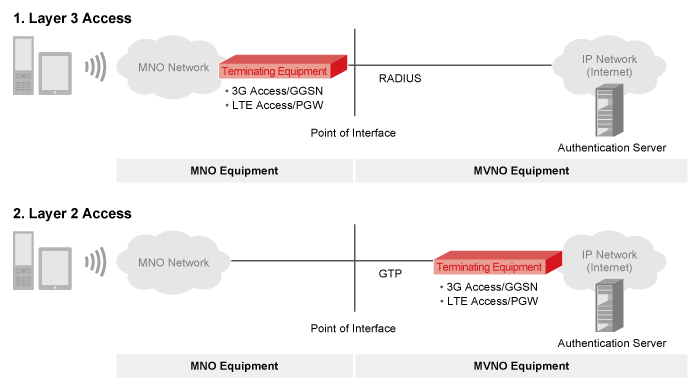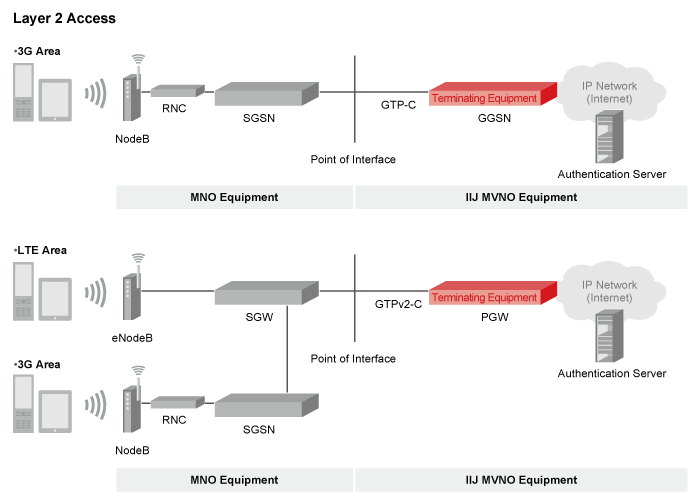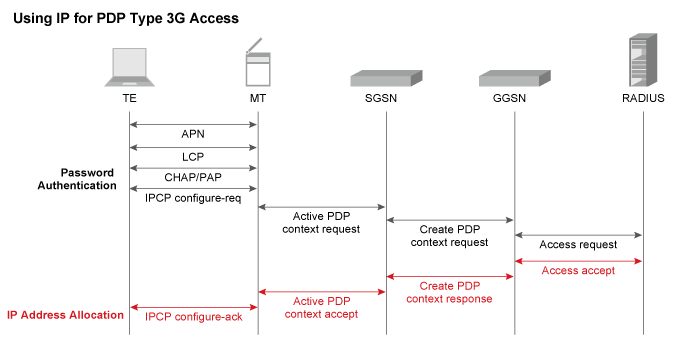Top of Page
- Links to move inside this page.
- HOME
- Technology
- IIJ Technology (archives)
- MVNO LTE Access
MVNO LTE Access
February 27, 2012
(Original Japanese article translated on September 21, 2012)
IIJ launched an LTE (Long Term Evolution) mobile access service in February 2012 to compliment the 3G mobile access service that it has provided since January 2008. Attention is mostly focused on speed and delays for LTE, but here we will touch upon 3G and LTE equipment and access methods.
Interconnectivity Methods
As an MVNO (Mobile Virtual Network Operator) provider, IIJ has interconnectivity with the MNO (Mobile Network Operator) NTT DOCOMO. Two interconnectivity methods are available for NTT DOCOMO.
- Using RADIUS as an access control protocol.
- Using GTP (GPRS Tunneling Protocol) as an access control protocol.
In general, the former is referred to as Layer 3 access, and the latter is called Layer 2 access. For Layer 3 access, MVNO providers only require an authentication server, while for Layer 2 access terminating equipment is required in addition to this. The following is a basic illustration of this.

IIJ provides interconnectivity using the Layer 2 access method, enabling a wide range of services unique to MVNO through coordination between the terminating equipment and authentication server. For example, in addition to standard Internet access, we also provide the IIJ Direct Access solution that enables cheap closed access, and the IIJ Mobile Biz+ Service that makes it possible to restrict Internet access to VPN, etc. We can also provide a wide variety of price plans because the authentication server aggregates traffic in real time, and in the interest of fairness we implement communications regulations based on QoS (Quality of Service).
Network Configuration Differences between 3G and LTE for Layer 2 Access
Next, we will examine network configuration differences between 3G and LTE for the Layer 2 access implemented by IIJ.

IIJ operates terminating equipment known as GGSN (Gateway GPRS Support Node) for 3G access, and PGW (Packet Data Network Gateway) for LTE access. The protocols used are GTP-C and GTPv2-C, respectively. Although the equipment names and protocols differ, they fulfill the same terminating role, and in some cases the GGSN and PGW functions are both implemented on a single piece of terminating equipment. This terminating role is to receive user access requests, and control authentication and access. A more familiar piece of terminating equipment would be a VPN server.
Currently LTE growth is in a period of transition, and its service area is limited compared to 3G. For this reason, by connecting the 3G network SGSN and the LTE network SGW, access to the IP network (Internet) using the 3G network is possible when outside the LTE service area. In general, LTE is given priority for access in areas where both LTE and 3G are available.
For mobile access, the handover between base stations as a device moves can be a point of concern, but the switch from a 3G area to an LTE area, and vice versa, is handled automatically. This process is called an inter-RAT handover. Of course, handover is also possible within the same area. When this kind of handover takes place, the terminating equipment interfaces with the SGW equipment on the MNO side and changes the communication route.
Points Regarding SIM Card and Device Combinations
In light of the above, let us take a look at user environments. User SIM cards may support either 3G or LTE. User devices may also support either 3G or LTE. The following chart shows the terminating equipment used for access in each of the possible combinations.
| SIM Card | Device | Area | Access/Terminating Equipment |
|---|---|---|---|
| 3G SIM | 3G Device | 3G Area | 3G Access/GGSN |
| LTE Area | - | ||
| LTE Device | 3G Area | - | |
| LTE Area | - | ||
| LTE SIM | 3G Device | 3G Area | 3G Access/GGSN |
| LTE Area | - | ||
| LTE Device | 3G Area | 3G Access/PGW*1 | |
| LTE Area | LTE Access/PGW*1 |
*1 LTE access is given priority when a user accesses the network.
There are two points to take away from this.
- An LTE SIM and 3G device combination enables GGSN access
- An LTE SIM and LTE device combination enables PGW access in any area
Here, we must note that when using an LTE SIM, the services available are restricted depending on the type of device. For example, PDP type access using PPP is only possible with a 3G device. This method is often used for embedded systems. Because most of the smartphones and USB devices in circulation use IP with PDP type access, there may be little general impact. Meanwhile, PDP type access using IPv6 or IPv4v6 is only possible on LTE devices. IPv6 is a next-generation Internet protocol, and its use is expected to spread in the future, but currently an LTE device is required to use IPv6 access. There are no major restrictions when using IP with PDP type access.
Dial-Up Connection using USB Devices
Last of all, I would like to discuss some interesting characteristics of the connection process. For both 3G and LTE access, dial-up connection is possible using USB devices. I believe some of you may have set a phone number along the lines of "*99***1#" before, but the sequence for the most common 3G PDP type access using IP is as follows.

PPP negotiation is normally carried out with the terminating equipment for dial-up connections, but as you can see above, the TE PC carries out PPP negotiation with the MT USB device. After PPP negotiation has progressed to a certain stage like this, a connection is initiated with the 3G network. With this kind of process, password authentication (CHAP/PAP) appears to succeed from the PC-side, even if a made-up PPP account and PPP password is entered. If password authentication later fails after communications with the RADIUS server, the device connection fails due to the IPCP configure-ack not being returned. However, there is no way of knowing that password authentication was the reason for the failure. The same point applies to LTE access.
This concludes our discussion focusing on 3G and LTE equipment and access methods. We will continue striving to provide a user-friendly Internet environment, developing a variety of services that take advantage of our strengths as an MVNO by actively adopting new technology.
Author Profile
Sotohide Miyamoto
Service Development Section, Network Service Department, Service Division, IIJ
Mr. Miyamoto joined IIJ in 1999. After working on the deployment and implementation of dedicated line access services, he moved on to network integration. Following this, he become involved in the development of enterprise-oriented network services, including those for VPN and mobile.
- Related Contents
End of the page.
